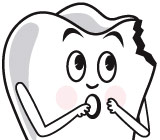The Importance of the Age One Dental Visit
 Did you know that the American Academy of Pediatric Dentistry recommends that all children have their first dental visit by the age of one? You might be surprised by this recommendation, since most children do not have many teeth at this age. However, it is important to start your child early on the path of good oral health!
Did you know that the American Academy of Pediatric Dentistry recommends that all children have their first dental visit by the age of one? You might be surprised by this recommendation, since most children do not have many teeth at this age. However, it is important to start your child early on the path of good oral health!
Here are a few things you can expect from this first dental visit:
- Developing a Rapport. Much of this visit will be dedicated to helping your child to feel at ease in our office. We’ll spend time talking to your child, so that he or she is comfortable sitting in the dental chair and being examined.
- Looking for Signs of Decay. During the comprehensive examination, we’ll be looking for any signs of tooth decay and conducting a risk assessment for potential future cavities. Keep in mind that baby teeth serve as guides for your child’s permanent teeth, so it is vital that you take proper care of them. You may not know it, but your child’s permanent teeth are already forming beneath the gums, and if teeth are lost early, there is a higher risk for orthodontic problems later in life.
- Reviewing Oral Hygiene Techniques. We would like this visit to be instructional and informative for you. Feel free to ask any questions that you have about caring for your child’s teeth. In addition, we’ll take some time during this visit to review with you the correct way to brush your child’s teeth.
- Talking about Oral Health Habits. We’ll also spend a portion of this appointment doing a bit of fact gathering to ensure that you’re not inadvertently doing anything that promotes decay, such as leaving a baby bottle with a sugary substance in your child’s crib at night.
If you would like more information about the age one dental visit, please contact us for a consultation.
Olivia Newton-John Recalls Daughter’s Teething Troubles
 Singer Olivia Newton-John’s daughter Chloe is now a lovely, grown woman, but Olivia recently recounted to Dear Doctor magazine a rather creative method she found to sooth Chloe’s teething troubles many years ago.
Singer Olivia Newton-John’s daughter Chloe is now a lovely, grown woman, but Olivia recently recounted to Dear Doctor magazine a rather creative method she found to sooth Chloe’s teething troubles many years ago.
“When Chloe was a baby and teething I remember using a frozen bagel for her sore gums,” Olivia said. “She loved it!”
Cold is often very soothing to a teething child’s gums. In fact, the American Academy of Pediatric Dentistry (AAPD) recommends using a clean, chilled, rubber teething ring, or cold wet washcloth. Chilled pacifiers can also be helpful. Be sure not to freeze teething rings or pacifiers as ice can actually burn sensitive mouth tissues.
Older teethers can sometimes find relieve from cold foods such as popsicles (or bagels!) but make sure your child eats these sugar-containing foods only at mealtimes so as not to promote tooth decay.
If your baby has not yet begun the teething (or tooth-eruption) process, you can expect it to begin usually between six and nine months. It may, however, start as early as three months or as late as twelve months.
Teething symptoms vary among children, as does the length of time it takes for a tooth to make its appearance. But many parents notice the following signs:
- Irritability
- Biting and gnawing
- Gum swelling
- Chin (facial) rash
- Disrupted sleeping patterns
- Ear rubbing
- Drooling
- Decreased appetite
These symptoms are usually most bothersome during the week that the tooth is breaking (erupting) through the gums, starting about four days before and lasting about three days after the tooth appears.
Occasionally, teething discomfort can be considerable. If that is the case with your baby, you can give her or him acetaminophen or ibuprofen in the appropriate dose (check with your pharmacist if you’re not sure what that is). The medicine should be swallowed — not massaged into the gums, as this can also burn. Numbing agents should not be used for children under 2, except under the advice and supervision of a healthcare professional.
If you would like to learn more about teething or any other child-related oral health issue, please contact us for a consultation.
If Your Child Chipped A Tooth, What Should You Do?
 Nearly every parent and caregiver has experienced that almost instantaneous sick feeling when they see that their child has been injured, especially when it is an injury to the mouth and teeth. For some, it is just a bloody lip; however, if the accident chipped a tooth, then you may have a completely different situation on your hands. If the nerve of the tooth has not been damaged, you needn’t worry too much — a composite (plastic) tooth-colored restoration that is actually bonded to the tooth is an ideal material for repairing most broken or chipped teeth. See us as soon as possible to assess the extent of injury, so that proper and appropriate action can be taken.
Nearly every parent and caregiver has experienced that almost instantaneous sick feeling when they see that their child has been injured, especially when it is an injury to the mouth and teeth. For some, it is just a bloody lip; however, if the accident chipped a tooth, then you may have a completely different situation on your hands. If the nerve of the tooth has not been damaged, you needn’t worry too much — a composite (plastic) tooth-colored restoration that is actually bonded to the tooth is an ideal material for repairing most broken or chipped teeth. See us as soon as possible to assess the extent of injury, so that proper and appropriate action can be taken.
An additional reason why bonding with composite resin may be the ideal choice for repairing a child’s chipped tooth is that it can be custom created in virtually any shade so that it perfectly matches the damaged tooth and the surrounding teeth. It is also far less expensive than a crown, an important factor to consider when repairing a primary (baby) tooth that will eventually fall out to make room for a permanent tooth. If the injury is to a permanent tooth, a composite resin still may be ideal to use as a restoration until your child or teenager has stopped growing or playing contact sports. This is because your teenager may be too young for a more permanent restoration such as a crown or porcelain veneer.
An important, proactive step you can take to be prepared for the next time your child has a dental injury is to download Dear Doctor’s Field-side Pocket Guide for Dental Injuries. This handy, quick reference guide is a must have for athletes, parents, caregivers, teachers, coaches or anyone who is often in an environment where a mouth injury is likely to occur. Knowing what to do and how quickly you must respond can make the critical difference between saving and losing a tooth.




